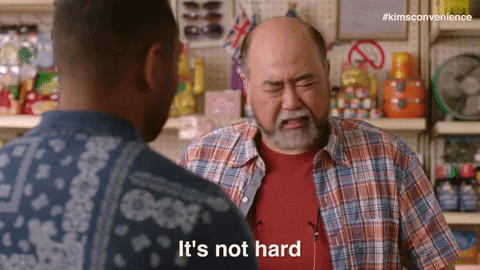- 🗞 News
- Last updated: Nov 9, 2022
- 10 Min Read
Can You Really, Truly Ever Understand Your Customers?
Written by

Verified by

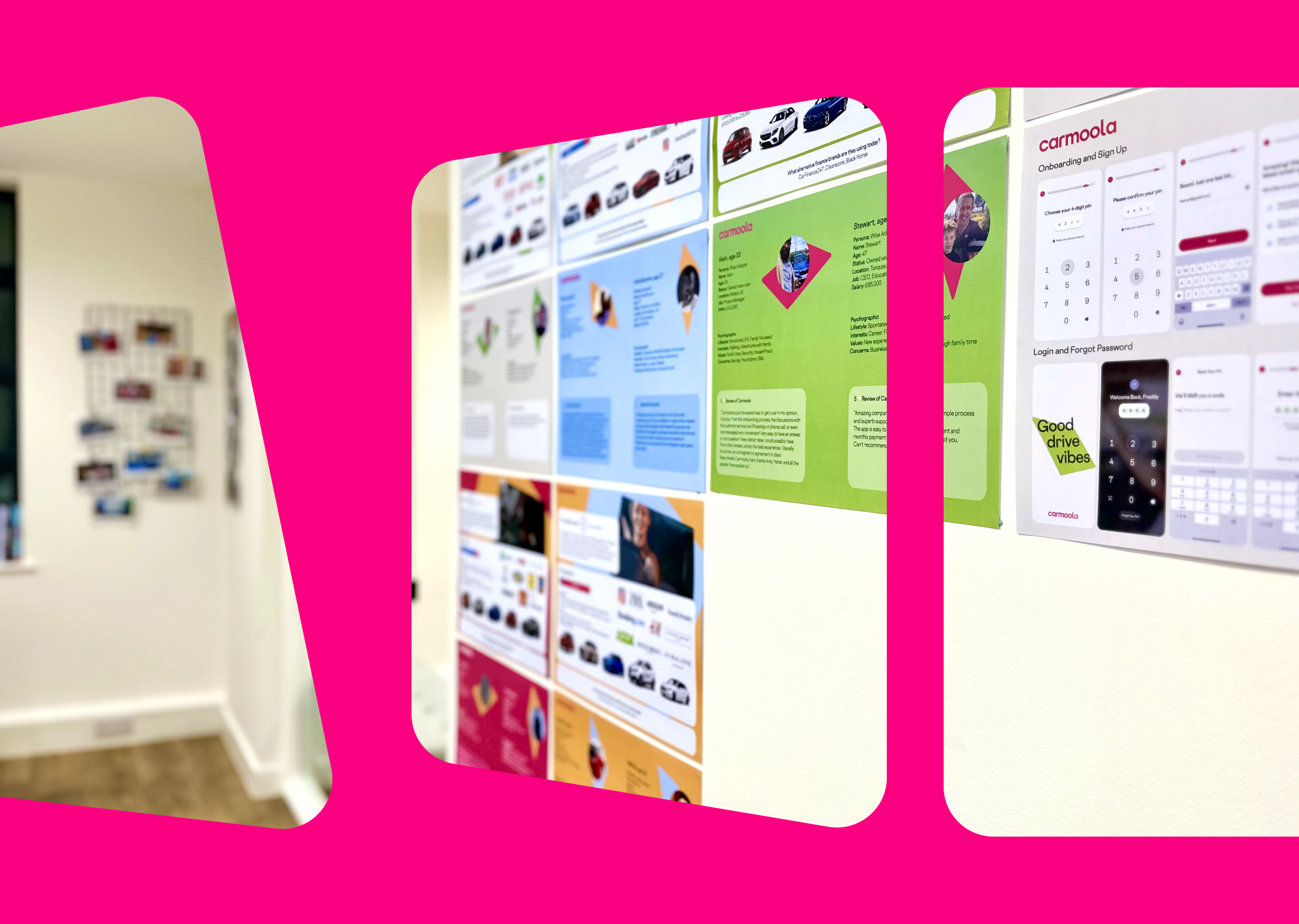
See how much you can borrow in 60 seconds
| Representative Example | |
|---|---|
| Loan amount | £10,000 |
| Interest rate | 13.9% APR |
| 54 payments of | £246 |
| Total cost of credit | £3,284 |
| Option to purchase fee | £1 |
| Total payable | £13,285 |
Customer segmentation. Marketing buzzword or a valuable tool for growth? We're fascinated to hear which side of the fence you sit on, and your experience with segmentation in your business. In this article, we're sharing our process, and how exactly we use segmentation at Carmoola, along with some ideas that we hope might be useful you 🤩
We're sure that any business wants to understand their customers, and why their product or service might be a good fit. For us, grouping our customers into segments means that we can begin to deeply understand the wants and needs of our the people who actually use and benefit from our product - customers who have already taken out a loan with us, and those that we believe we can help buy their dream car in the future. Segmentation helps us to tailor our messaging at every touch point - our marketing creative, product journey, customer support approach, collections strategy... and so on! Every discussion we have internally can ultimately be tied back to the question "which customer segment is this feature/advert/process/communication made for?".
So, what's the goal for customer segmentation?
For each customer segment, the goal is to get to a point where we can describe exactly what that customer is like. This can be basic demographics such as age, gender, where they tend to live, what they tend to earn, what they do for a living etc. As a lending business offering car finance, we also have to consider if there is any correlation in how they tend to use credit, their credit profile, their prior experience with other finance alternatives and the sorts of cars they are looking to buy.
Aside from this, we dig deep into the language they use, their psychographics (quite a cool article on this here if you've not used it before), the sorts of brands they love, real life pains they're experiencing that our product could solve, vs potential gains that would enhance their lives if they used our product. Again, a cool article on pains and gains here if you fancy it!
During our process we actually landed on five segments that were quite prominent in our customer base, however at Carmoola we believe in keeping things simple, so we've narrowed them down to just three core target segments for the time being. Within those three, we cover around sixty percent of our existing customer base, indicating that the segments align nicely with our real customers. Here's an example of how we visualise our segments, in this picture, the Wise Adopters.
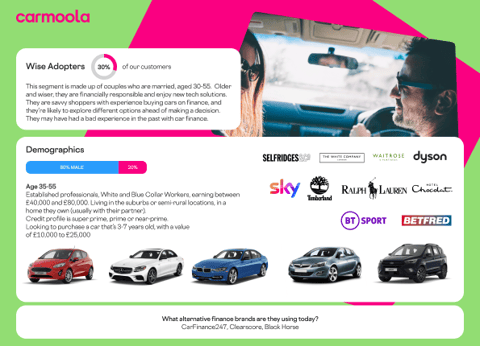
Let me take you back to December 2021. Carmoola's regulatory process was well on the way towards getting a Consumer Credit licence, and our creative team were working hard on researching how exactly we were going to take this product to market and reach customers with a relevant message. Without any live customers, we had to build our initial segmentation from market research, and interviews with potential customers who may or may not have experienced car finance before. However, we were aware that these would need to be reviewed once we went live and started growing our customer base. As we acquired actual customers (and therefore real data), we continued to question whether the original segments were fit for purpose, and representative of who was now using the product.
We're constantly wowed by our customers and how much they want to share with us, and this openness is incredibly valuable in terms of understanding them better, and ultimately delivering more and more value to them. Our customers love to share pictures of themselves and their new car, stories and pictures from adventures they've been on, and are always up for a chat to provide feedback on what they'd love to see us do next. Aside from this, we found a lot of insight in our Trustpilot reviews, where many customers have shared exactly what they found most valuable about the product and or experience, and why they chose Carmoola.
Let's walk through the process we used recently to re-define our segments - customer reviews, customer data, customer operations team feedback and speaking to real life customers.
Alright then, let's see how the magic happens ✨
Step 1: What's the word on the street?
We looked at our reviews across Trustpilot, Google, NPS (which we collect in the product), the App Store, and the Play Store to see what real customers are saying about us, capturing information about why they chose Carmoola and what they particularly liked. We matched these reviews with our real life customers and started collating the information to build out some high level trends. We put these in categories using both our pre-launch segments and some thoughts around potential new ones.
From the reviews, we were able to start understanding the language of the different segments. Do they refer to our product as "car finance"? Or do they tend to use "car loan"? Do they buy from a "garage", or a "dealership"? We found this incredibly useful later in the process when developing lexicon for that segment.
At the end of this first stage, we had organised our real life customer reviews, and started to build up a picture of how they fit into existing segments, and also some ideas for new customer segments that we hadn't seen before ✅
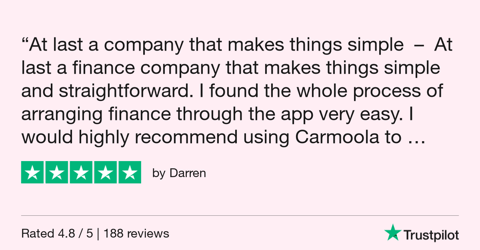
Step 2: Involve the experts 💡
If anyone knows our customers wants, needs, challenges, and concerns, it's our Customer Operations Team. Whilst a large part of the product journey is automated, we are passionate about providing incredible support to our customers whenever they need us. In fact, if you call us between 8am - 9pm, any day of the week, you'll speak to a real human in less than 3 minutes. Go on... test us out 😉
We wanted to test our learnings and assumptions gathered from the reviews with our Operations Team, to see whether the trends and segments we were discovering out aligned with the real people they were speaking to, learn more about what was motivating these customers to buy a car with Carmoola, and lastly to get additional feedback on whether we were missing any other trends. Armed with this additional colour, we refined the shape of our segments further, in fact we ended up grouping two segments together, and removing another one entirely.
By this stage, we had some hypotheses around what our customer segments might look like, including some high level indicators of demographics, but we needed to cross reference this against what is actually in our data.
Step 3: Talk data to me 📊
Now, we get to the exciting bit (if you're that way inclined!), our real life customer and behavioural data!
We found it useful to start pretty high level here, and actually park the reviews and insights we'd found in the previous two steps (pun intended). Ignoring the segments we started building earlier enabled us to delve into the data with fresh eyes, ready to spot more quantitative trends. We started cutting the data using facets such as age, gender, salary, credit score, occupation, industry, behaviour in the product and other factors.
After some trends began to emerge, we were able to overlay the high level segments we had started building in steps one and two and started to lock down some hard cuts and boundaries in the data for each segment. For example, one segment would be made up of customers who earn between X & Y £ per month, they are aged between A and B. This took several iterations, it's unlikely you'll get it perfectly right first time, so don't worry! But eventually we were able to validate our hypotheses built out in stages one and two, and align them to the actual data.
At the end of this step, we had a relatively clear picture of five segments in total, three of which stood out as core customer segments, including actual demographic data and some hypotheses of the behavioural elements of each group that we believed was driving customers to choose Carmoola.
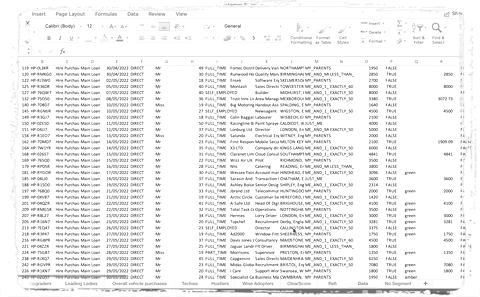
Step 4: Nothing beats an honest conversation 😊
We're super lucky that our customers are so open and honest, and so we were keen to learn more by speaking to them directly. We wanted to begin to validate our hypotheses and build up a more solid picture of the psychographics, pains and gains of the customers within each segment. For this final step, we spoke to real customers and asked them some of the following questions. Also useful to note that using open questions that encourage descriptive, rambling answers is way more useful than closed questions that just garner a response of "yes" or "no".
- Tell us about your previous experience(s) with car finance
- What prompted you take the plunge and buy a car?
- How did you decide on the car that you wanted?
- How did you research your options on how to pay for your car?

We used the output of this final step to refine and finalise our segments, particularly focussing on bringing them to life with real life examples of customer comments, photos, personas and reviews. It gave us a huge amount of confidence that the three core customer segments were very closely aligned to the majority of our customer base.
Of course, we highly recommend sprinkling on a bit of design magic, once you've got the content nailed!
Bonus content for reading this far! Our top tips for customer interviews ⭐️
- Emphasise how much you value the customer's input and time and thank them in advance for their help
- Start with the easy questions to get the conversation flowing
- Ask open questions, these usually start with "tell me about", "how", "what", "where" or "why"
- Always allow the customer to share any other thoughts or feedback at the end
That's all folks!
With these four steps, we've got ourselves three distinct, core customer segments that we can use to tailor our messaging across all channels, our upcoming product features, our collections strategy and soooo much more. As with anything, we'll be learning as we go and we're not saying it's perfect - we’ll keep tweaking the segments as we understand more about our customers and update our segments and everything we do around them to match.
One final thought to leave you with. As useful as this process is for the team members who are closely involved, the segments mean nothing if you don't actually use them in day to day running of the business, and share them in detail with the whole team. So next time you kick off a new project, product feature, marketing campaign or other initiative, ask yourself...
"Which customer segment are we creating this for?
See how much you can borrow in 60 seconds
| Representative Example | |
|---|---|
| Loan amount | £10,000 |
| Interest rate | 13.9% APR |
| 54 payments of | £246 |
| Total cost of credit | £3,284 |
| Option to purchase fee | £1 |
| Total payable | £13,285 |
Related articles
What Is GMFV in PCP Car Finance? Guaranteed Minimum Future Value Explained
GMFV, or Guaranteed Minimum Future Value, is the amount your lender estimates your car will be worth at the end of your PCP...
Does Financing a Car Build Your Credit?
Financing a car can build credit when you make payments on time, but it can damage your score if you miss payments or take on...
Car Refinancing: What Is It and How It Can Lower Your Monthly Payments
Refinancing your car can give you benefits like lowering your monthly payments or reducing interest costs, depending on your...

.webp?width=832&height=592&name=customer-support%20(1).webp)










.webp?width=400&height=285&name=online-shoppers-with-dog%20(1).webp)


.jpg?width=500&height=356&name=Vintage%20car%20going%20to%20an%20old%20town-1%20(1).jpg)



